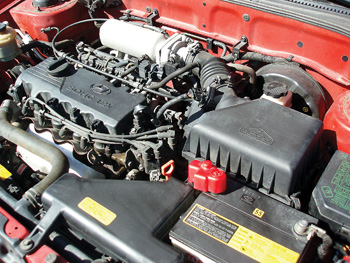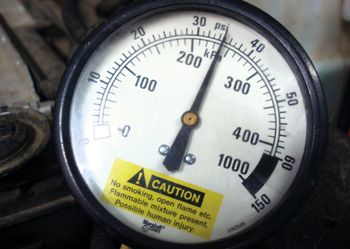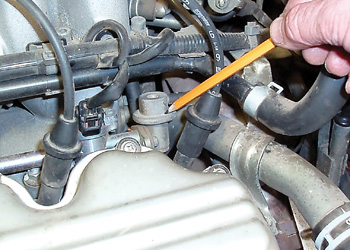Are you leaving money “on the table” when you sell fuel system parts? If you’re not familiar with the various configurations of fuel system and fuel pump components, probably so. Worse still, leaving money on the table can result in a partial fuel pump repair that will actually invite customer complaints and warranty comebacks. Let’s look at some common oversights in selling fuel pumps and related parts.
Low-Pressure Supply Pumps
 Many 1970s-1980s import and domestic vehicles used a frame-mounted fuel pump. Some of the early Volvos, for example, required at least 80 psi fuel pressure to properly perform. But there are some caveats in selling frame-mounted fuel pumps. Most frame-mounted fuel pump configurations require an in-tank, low-pressure supply pump to force fuel into the frame-mounted pump, generally at less than 8 psi fuel pressure. When the in-tank pump begins to fail, it will often cause the frame pump to overheat and fail due to insufficient fuel being forced into the pump. But keep in mind that low-pressure, in-tank and engine-mounted supply pumps are currently used in most diesel applications to supply fuel to the engine’s high-pressure injection pump. In addition, modern direct fuel injection systems use a conventional in-tank fuel pump to supply fuel to a mechanical high-pressure fuel pump mounted on the engine. So don’t leave money on the table and create a potential warranty complaint by not doing your homework on supply pumps.
Many 1970s-1980s import and domestic vehicles used a frame-mounted fuel pump. Some of the early Volvos, for example, required at least 80 psi fuel pressure to properly perform. But there are some caveats in selling frame-mounted fuel pumps. Most frame-mounted fuel pump configurations require an in-tank, low-pressure supply pump to force fuel into the frame-mounted pump, generally at less than 8 psi fuel pressure. When the in-tank pump begins to fail, it will often cause the frame pump to overheat and fail due to insufficient fuel being forced into the pump. But keep in mind that low-pressure, in-tank and engine-mounted supply pumps are currently used in most diesel applications to supply fuel to the engine’s high-pressure injection pump. In addition, modern direct fuel injection systems use a conventional in-tank fuel pump to supply fuel to a mechanical high-pressure fuel pump mounted on the engine. So don’t leave money on the table and create a potential warranty complaint by not doing your homework on supply pumps.
Fuel Filters
During the 1990s, most manufacturers began integrating their fuel filters into a fuel pump module that also contained the fuel level gauge and fuel pressure regulator. Consequently, it’s easy to forget the many vehicles on the road that are still equipped with frame or engine-mounted fuel filters. The problem with replaceable fuel filters is that they can clog with sediment and cause many intermittent low-power engine performance complaints. Not only that, a partially clogged fuel filter can cause a premature fuel pump failure because the pump must work much harder to force fuel through a clogged fuel filter. So, when selling a non-modular fuel pump, avoid warranty returns and add to your bottom line by suggesting a fuel filter replacement.
Fuel Pressure Regulators
 The fuel pressure regulator is usually mounted at the end of the fuel injector mounting rail on conventional dual-line fuel injection systems. As mentioned above, the fuel pressure regulator is contained internally on most single-line, modular fuel pump assemblies. The difference between dual and single line systems is that the dual-line system is made up of a high-pressure fuel supply line and a low-pressure fuel return line from the pressure regulator to the fuel tank. The single-line system returns pressure from the regulator directly to the fuel tank.
The fuel pressure regulator is usually mounted at the end of the fuel injector mounting rail on conventional dual-line fuel injection systems. As mentioned above, the fuel pressure regulator is contained internally on most single-line, modular fuel pump assemblies. The difference between dual and single line systems is that the dual-line system is made up of a high-pressure fuel supply line and a low-pressure fuel return line from the pressure regulator to the fuel tank. The single-line system returns pressure from the regulator directly to the fuel tank.
Fuel pressure regulators can affect fuel pump performance if they fail. In some rare cases, the internal pressure regulation spring can break, which will reduce fuel pressure. In most cases, the pressure regulator will stick closed or the return line will become restricted, which will cause the fuel pump to operate at maximum or “dead-head” fuel pressure. High fuel pressure will cause the engine to run very rich on fuel and also might create a potential warranty situation by causing the new fuel pump to fail. To reduce warranty returns, it’s important to suggest a before-and-after fuel pressure test on any new fuel pump replacement.
 Fuel Tanks
Fuel Tanks
All too often, vehicles are refueled from a badly rusted or dirt-contaminated fuel tank or can. In some cases, finely granulated dirt will be filtered out in the fuel filter but, in most cases, larger granulations of dirt will clog the filter screen attached to the fuel pump inlet and starve the pump for fuel.
Whenever a fuel pump is replaced, the tank should be inspected for dirt contamination, for loose fuel pump baffling, and for dents or distortions that can restrict fuel entry into the fuel pump or fuel exit from the pressure regulator return line. In some cases, a fuel tank can be cleaned with a hot solution of water and detergent, but in other cases, it’s more cost-effective to replace the fuel tank. But, if the plastic anti-sloshing baffles have become dislodged from the fuel tank itself, the tank should be replaced with one of the many available from OE or aftermarket sources. So keep track of your aftermarket sources for replacement fuel tanks. It’s an important problem-solver and profit center.
Low Fuel Level Effects
Warranty issues always subtract from a store’s bottom line. If you have a customer who appears to have more than his share of fuel pump failures, it’s a good bet that he’s running his fuel tank nearly dry before refueling his vehicle. Even with adequate baffling in the fuel tank, low fuel levels tend to cause the fuel pump to ingest air during acceleration, cornering and braking. Since modern high-speed fuel pumps require gasoline to lubricate the pump bearings and cool the pump itself, it’s cheaper in the long run to run on the top half of the fuel tank.
One of the most important tips for diagnosing a fuel delivery problem is to check the PCM for trouble codes indicating a faulty fuel level sensor or sending unit. Another tip is to compare the fuel gauge reading with the relative level observed in the fuel tank after the pump assembly has been removed. If the fuel gauge proves to be inaccurate, it’s entirely possible that the driver is running his vehicle too low on fuel.
Relays And Resistors
When I replace a fuel pump on a vehicle with more than 100,000 miles on the odometer, I try to increase the reliability of the repair by replacing the fuel pump relay as well. A relay wears out because it’s an electrically operated switch with two tungsten contacts that connect the fuel pump to battery voltage. In many cases, the relay contacts oxidize and fail to close properly, which can create an intermittent cranking, no-start complaint. In other cases, the contacts can stick together, which allows the fuel pump to drain the battery with the ignition turned off. Considering its low cost, adding a relay to the fuel pump replacement invoice can add to profits and eliminate many potential warranty return complaints.
Although two-speed fuel pumps are relatively rare, many Jeep vehicles produced in the late 1980s and early ‘90s are equipped with two-speed fuel pumps. Basically, the two-speed fuel pump runs at low speed during idle and part-throttle to eliminate the irritating buzzing noise of the fuel pump. As the throttle opens, the PCM switches the pump to high-speed operation. A primary low-speed component is the fuel pump resistor located on the driver’s side fender well. If the resistor fails, the fuel pump will not operate. In addition, the resistor block provides a handy testing point to measure available voltage and current draw for the fuel pump. Here again, replacing the fuel pump resistor will increase the reliability of the fuel pump installation.
Direct Fuel Injection Systems
As mentioned above, direct fuel injection systems include a conventional fuel pump located in the fuel tank that supplies fuel to a high-pressure mechanical fuel pump located on the engine. Because the high-pressure pump can produce well in excess of 1,000 psi fuel pressure, the steel fuel lines must be replaced when the high-pressure mechanical fuel pump or injection system is removed for service or replacement. For safety reasons alone, diagnosing and repairing direct fuel injection systems is best left to our service professionals.













